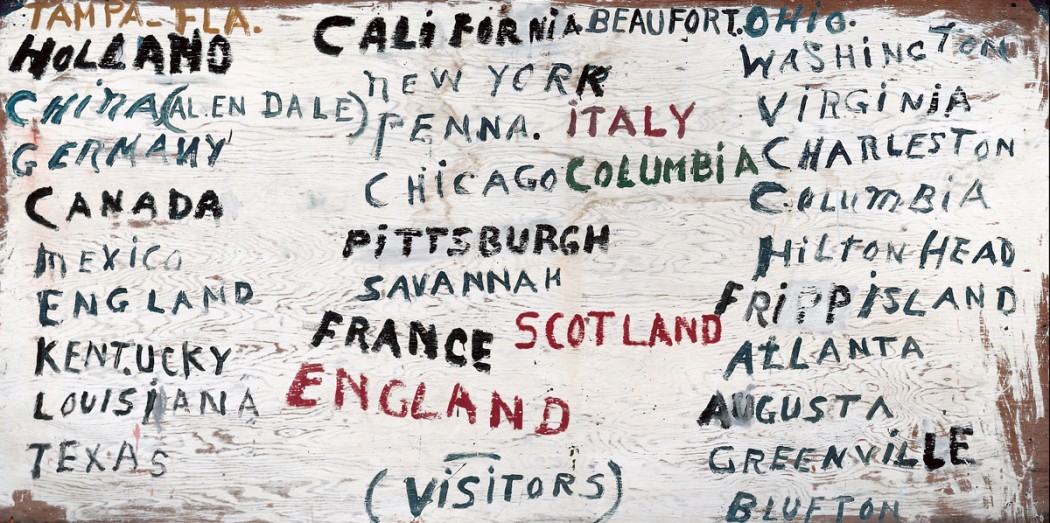LACMA Presents Last Week of Sam Doyle
Art of the Americas Building, Level 3
May 3, 2014–September 1, 2014
LOS ANGELES Museum of ART: Sam Doyle was born in 1906 on Saint Helena Island, South Carolina, the center of the region’s Gullah community, where African influences thrived. He began making paintings on cast-off sheet metal and wood panels in 1944; most were portraits of people and events important to his community. He displayed the paintings to the public in the yard of his clapboard house. By the time Doyle retired in the late 1960s, his history lesson had evolved into the Saint Helena Out Door Art Gallery. In 1982, Doyle was featured in the seminal exhibition Black Folk Art in America: 1930-1980 at the Corcoran Gallery of Art in Washington, DC, which introduced the islander’s impassioned artwork to a broader audience that included artists such as Jean-Michel Basquiat, who collected Doyle’s work, and Ed Ruscha.
Known for a wide-ranging palette of vibrant colors, Doyle’s approach to painting can be characterized as gestural figuration. The artist composed his figures sign-like and painted in a style that is flat and frontal. The industrial or even architectural materials on which he painted also suggest this reading. Doyle’s works are to be read both visually and literally, as many include painted words that he added to further inform the viewer about this subjects, who were not just subjects of interest but unique personalities. The portraits in this exhibition primarily depict residents of Saint Helena, though they also include important figures from the wider world of entertainment and sports. All are testament to Doyle’s reverence for the spirit of individuals and the culture of his community.
Sam Doyle: Haints and Saints
Sam Doyle: Haints and Saints was written by Gordon W. Bailey. This article was excerpted from RV61, WInter 2007 Raw Vision Magazine.
Sam Doyle was born in 1906 on Saint Helena Island, South Carolina, the center of the region’s Gullah community, where African influences thrived. He began making paintings on cast-off sheet metal and wood panels in 1944; most were portraits of people and events important to his community. In 1982, Doyle was featured in the seminal exhibition Black Folk Art in America: 1930-1980 at the Corcoran Gallery of Art in Washington, DC, which introduced the islander’s impassioned artwork to a broader audience that included artists such as Jean-Michel Basquiat, who collected Doyle’s work, and Ed Ruscha.
Known for a wide-ranging palette of vibrant colors, Doyle’s approach to painting can be characterized as gestural figuration. This publication features information about Sam’s life, the development of his outdoor museum and his working style. Several large reproductions of his work or working materials are included.
About LACMA
Mission Statement | History | Board of Trustees | Executive Staff | Corporate Governance
Since its inception in 1965, the Los Angeles County Museum of Art (LACMA) has been devoted to collecting works of art that span both history and geography, in addition to representing Los Angeles’s uniquely diverse population. Today LACMA is the largest art museum in the western United States, with a collection that includes over 120,000 objects dating from antiquity to the present, encompassing the geographic world and nearly the entire history of art. Among the museum’s strengths are its holdings of Asian art, Latin American art, ranging from pre-Columbian masterpieces to works by leading modern and contemporary artists; and Islamic art, of which LACMA hosts one of the most significant collections in the world. A museum of international stature as well as a vital part of Southern California, LACMA shares its vast collections through exhibitions, public programs, and research facilities that attract over a million visitors annually, in addition to serving millions through digital initiatives, such as online collections, scholarly catalogues, and interactive engagement at lacma.org. Situated in Hancock Park on over 20 acres in the heart of Los Angeles, LACMA is located between the ocean and downtown.
In April 2006, Michael Govan became CEO and Wallis Annenberg Director of LACMA. Formerly president and director of Dia Art Foundation and deputy director of the Solomon R. Guggenheim Museum, Mr. Govan is the seventh director in LACMA’s 46-year history.







